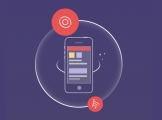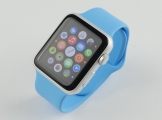|
我需要将 UITabBarController 子类化,这样我就可以用我希望在界面生成器中生成的自定义 View 完全替换 UITabBar View 。我试过了,但没有成功。
首先,我创建了 UITabBarController 的子类以及 xib。我删除了 xib 中的默认 View ,并用一个只有 60 像素高(我的标签栏大小)的新 View 替换了它。我将必要的按钮拖到它上面,并像这样配置 .h 文件:
@interface ToolbarViewController : UITabBarController
@property (strong, nonatomic) IBOutlet UIView *tabBarView;
@property (strong, nonatomic) IBOutlet UIButton* firstButton;
@property (strong, nonatomic) IBOutlet UIButton* secondButton;
@end
我的 xib 看起来像这样:

当我启动应用程序时,我看到底部有一个空白区域用于标签栏,但我没有看到实际的标签栏:

更新:我意识到我实际上并没有在 .m 文件中启动 xib 文件。任何人都知道我该如何正确地做到这一点?
Best Answer-推荐答案
有多种不同的解决方案可以将一组自定义按钮添加到自定义标签栏 Controller 子类。几年前我按照本指南完成了它:http://idevrecipes.com/2010/12/16/raised-center-tab-bar-button/ .
这个想法是在你的 UITabBarController 子类的标签栏上添加一个自定义 UIView。 CustomTabBarController 类不必有 xib。相反,我有一个 UIView 的子类,它可以以编程方式布局,也可以使用 xib 为 UIView 创建。这是我的 CustomTabBarView 类的头文件:
@interface CustomTabBarView : UIView
{
CALayer *opaqueBackground;
UIImageView *tabBG;
IBOutlet UIButton *button0;
IBOutlet UIButton *button1;
IBOutlet UIButton *button2;
NSArray *tabButtons;
int lastTab;
}
@property (nonatomic, weak) id delegate;
-(IBAction)didClickButton id)sender; id)sender;
您可以将所需的按钮连接到 xib 文件中的 button0、button1、button2 等,或者在 View 的 init 上以编程方式进行。请注意,这是 UIView 子类。
在 CustomTabBarView.m 中:
-(IBAction)didClickButton id)sender {
int pos = ((UIButton *)sender).tag;
// or some other way to figure out which tab button was pressed
[self.delegate setSelectedIndex:pos]; // switch to the correct view
} id)sender {
int pos = ((UIButton *)sender).tag;
// or some other way to figure out which tab button was pressed
[self.delegate setSelectedIndex:pos]; // switch to the correct view
}
然后在您的 CustomTabBarController 类中:
- (void)viewDidLoad
{
[super viewDidLoad];
// Do any additional setup after loading the view.
tabView = [[CustomTabBarView alloc] init];
tabView.delegate = self;
tabView.frame = CGRectMake(0, self.view.frame.size.height-60, 320, 60);
[self.view addSubview:tabView];
}
当在 CustomTabBarView 中单击按钮时,它将调用其委托(delegate)函数,在本例中为 CustomTabBarController。该调用与单击实际选项卡栏中的选项卡按钮的功能相同,因此如果您像普通的 UITabBarController 一样正确设置了 CustomTabBarController,它将跳转到选项卡。
哦,稍微单独说明一下,添加自定义 xib 作为 UIView 子类的接口(interface)的正确方法:
- (id)initWithFrame CGRect)frame
{
self = [super initWithFrame:frame];
if (self) {
// Initialization code
NSArray *subviewArray = [[NSBundle mainBundle] loadNibNamed:NSStringFromClass([self class]) owner:self options:nil];
UIView *mainView = [subviewArray objectAtIndex:0];
//Just in case the size is different (you may or may not want this)
mainView.frame = self.bounds;
[self addSubview:mainView];
}
return self;
} CGRect)frame
{
self = [super initWithFrame:frame];
if (self) {
// Initialization code
NSArray *subviewArray = [[NSBundle mainBundle] loadNibNamed:NSStringFromClass([self class]) owner:self options:nil];
UIView *mainView = [subviewArray objectAtIndex:0];
//Just in case the size is different (you may or may not want this)
mainView.frame = self.bounds;
[self addSubview:mainView];
}
return self;
}
在 xib 文件中,确保 File's Owner 将其自定义类设置为 CustomTabBarView。
关于ios - 如何继承 UITabBarController 并替换其 UITabBar View ?,我们在Stack Overflow上找到一个类似的问题:
https://stackoverflow.com/questions/25919509/
|  客服电话
客服电话
 APP下载
APP下载

 官方微信
官方微信



















 id)sender;
id)sender;

